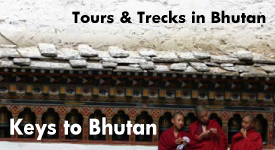Nangi Village: a Travel Synthesis by Sujan Koirala
(September 3 – 8, 2010)
PEN President Sujan Koirala explored Nangi village of Ramche Village Development Committee (VDC) of Myagdi District during September 4 – 7, 2010. Here is the travel report in his word.
– – – – – – –
Introduction to Nangi village
Nangi village is located in western Nepal on the Southern flank of the Annapurna and Dhaulagiri ranges of the Himalayas. Dhaulagiri I (8,167m, 26,795 ft) and Annapurna I (8,091 m, 26,545 ft) are the seventh and the tenth highest peaks of the world respectively.
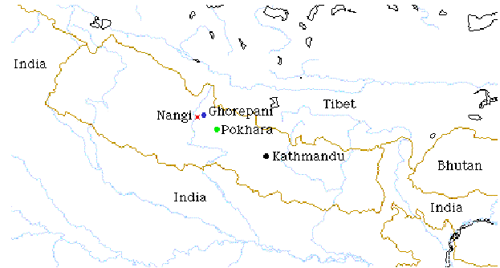
Location of Nangi Village
Reaching Nangi village usually requires two to three days of traveling from Kathmandu. From Kathmandu, it is a 7 hours bus ride or 35 minute plane trip to Pokhara, the second largest city in Nepal. From Pokhara, one must travel by bus or taxi for 3 to 5 hours to reach Beni, the nearest bus–accessible town to Nangi. One can directly go to Beni from Kathmandu which requires 10 to 12 hours bus ride. The hike into Nangi usually takes between six to nine hours, and includes an ascent through several mountain villages and forests. The elevation of Nangi village is about 2,260 m. (7,345 ft).
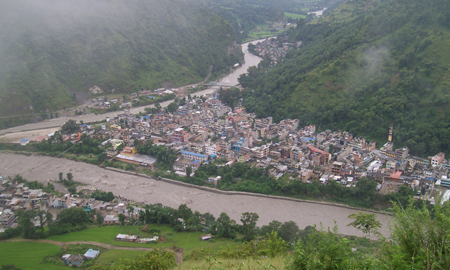
Beni
Overview
The plan to visit Nangi village came to my mind while I was in a dilemma in choosing the topic for my Masters of Philosophy thesis. Few months of reviewing literatures in developing idea did not produce any relevant result. Then, I recalled the meeting with respected Dr. Mahabir Pun which was held on February 6, 2010 at Fuji Hotel. I was quite impressed by his efforts in bringing changes in remote mountain areas of Nepal. At the meeting, he had promised to help in my research. Mahabir Pun is a renowned figure in Nepal who was awarded with the Ramon Magsaysay (some considered as the Nobel Prize of Asia) for the community leadership in 2007. He connected his remote mountainous village Nangi to the rest of the world by implementing wireless computer technology in remote Nepal. I wrote several emails and attempted to get an appointment but he was quite busy in preparation of papers for seminars to be held in abroad. In the course of time, I came to know that Satomi Tsuneta, a friend from Japan, is also coming in Nepal to volunteer in Nepal Wireless Network Project which was initiated by Mahabir Pun. After Satomi’s arrival in Nepal (August 18), I could meet Mahabir Sir in several occasions. Even, I could facilitate Satomi in her meeting with Mahabir Sir. Satomi left for voluntary works in Nangi and other places on August 22. Mahabir Sir insisted me to visit Nangi to get clear picture and idea for the research. Then, I set my mind for leaving for Nangi. My purpose of visiting Nangi was not only to develop the research idea but also to support Satomi in her voluntary activity.
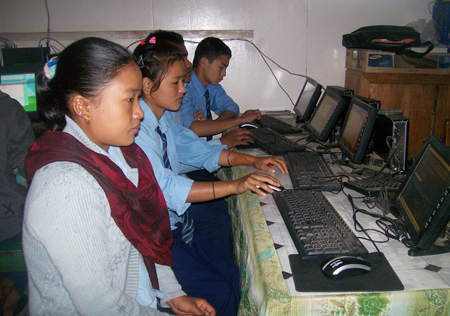
Before leaving for Nangi, I could have a small meeting with Mahabir Sir on September 2, 2010 at near his residence in Kathmandu. He gave some important advices and tips for my research as well as for my trip and also wished a happy journey to Nangi.
Day 1: Friday September 3, 2010
I left for Nangi at 7.30am from my home and took a bus for Beni from New Bus Park at 8.15am. I could have lunch at Mugling. It took nearly twelve hours to reach Beni. It was raining throughout the way. In some parts there were floods and landslides which were adding the time of travelling. Let me mention here an incident about which I never thought of. While reaching near Baglung (about one hour to Beni), the bus driver and conductors said, “The road to Beni is totally damaged due to rains and it can’t go further.” There were just three passengers a lady with a little baby and myself. We were very anxious as we didn’t have any person who can help us there. The area was totally dark due to load-shedding. Even, we were unknown whether we could get any lodge or guest house. We were quite angry and burst into the driver. After neck to neck discussion, the driver agreed to arrange a vehicle that will take us to Beni. After some efforts, he could find a Japanese Toyota car which was small but capable enough to pass through the damaged road caused by landslides and floods. Passing through very damaged and dangerous road ever, we reached Beni. It was already 8.00pm when I arrived at Beni.
The twelve hours traveling had made me very tired so after having dinner, I went to bed. That night, I stayed at Dolphin Hotel. Since this was my first visit and I was alone, I was worrying regarding how to get to Nangi the day after. I phoned Mahabir Sir as he had told me to contact right after reaching Beni. As it was already 8.45pm, he told me to call the next morning.
Day 2: Saturday September 4, 2010
The next morning, I woke up at 7.00am and called Mahabir Sir. He told me that a woman will come at hotel who will guide me to Nangi. I was desperate to meet her. While coming down to the lobby, I could find a middle aged lady waiting for me. I was extremely delighted and all my worries disappeared. Her name is Banika Gerbuja, a health worker who lives in Ramche VDC, one and half hour further walk from Nangi. After having breakfast together, we headed for Nangi at 8.00am. She told me that it will take six to nine hours hard trek.
The journey began crossing a long hanging bridge right after passing the Beni Bazaar. The climate was cloudy while we started the trek. From the very beginning, we had to climb steep up. With water, chocolates, cucumber, teas, bananas and taking rests, we progressed slowly and gradually hills after hills. Since we were talking, the journey became quite easy. Physically it was tough but I was totally committed and motivated to forget the difficulty. After nearly four and half hours of steep climbing, we could reach the place called Falame, the end point of steep climbing at 12.30pm. We had passed through various mountain villages including Mallaas and Battase as well as many forests before arriving at Falame. I felt that I have overcome a great battle reaching at the top. The partly showers throughout the way made me totally wet. The absence of the sun eased our walking.
Then, the straight road began. In nearly three hours of walking, we could reach Nangi village, my destination at 3.15pm. But she had to walk one and half hour more further to reach Ramche. As it was Saturday, the weekly holiday at school, I could not see any person out there. After interrogation with a shopkeeper near the school, I knew that the in-charge of the school including Satomi and a German volunteer had gone for a tree-plantation programme in the nearby village. To kill my tiredness, I had no choice than to take rest and wait in the school premises along with some cups of tea. My clothes were wet; more than that the condition of the shoes was worth-watching. The whole day rains stopped and I could see some glimpse of sun. I thanked God for bringing changed atmosphere. My waiting came to an end when I saw the in-charge of the school Chandra Sir (Chandra Phal), Moti Bahadur Purja (a very old man better known as Nursery Baa), Satomi and a Germany volunteer Chris (Christopher Prilop) after nearly forty five minutes of waiting.
Satomi introduced me to Chandra Sir and others. Chandra Sir managed a room for me at the round house (volunteer house). I was happy to build relationship with Chandra Sir, Chris and others at the school. Madam Hem Kumari prepared a dinner for us. In spite of my tiredness, I could manage to talk with Satomi, Chandra Sir, Chris and Hem Kumari Madam. I could have a very nice and long sleep that night.
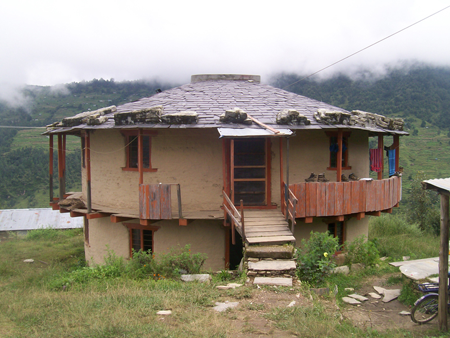
Day 3: Sunday September 5, 2010
The next morning, Chandra Sir told me, “If there is any network, I would invite you to see the telemedicine.” Each morning 8am onwards Nangi Health Post and Kathmandu Model Hospital involved in telemedicine. But that day, it didn’t work due to network problem. Then, I began to extract information with teachers who appeared in the school one after another. As per the information received, there are altogether 26 teachers and 240 students (from Playgroup to Grade 12).
I could have a very good conversation with Krishna sir about the village, school, teachers, students as well as other issues. I asked him whether the wireless technology has brought any changes in the village. He replied that in terms of information/communication and health, the wireless technology has tremendously helped. In one click, the news of world can be obtained. Similarly, the communication between villagers and their family members who are working abroad have become easier and cheaper. In past, the villagers had to depend on mail service which required months in exchanging news and even costly too. The villagers are also getting very good health service and consultancy through telemedicine at Nangi clinic. He also shared about the “Hatbazaar” (e-commerce) through which they had attempted to market the farmed products including their cattle. However, it was not that effective due to lack of a coordination mechanism. They were trying to make it more effective. He further told that the teachers were not utilizing the technology properly in generating resources that are relevant to the students. He stressed that the teachers should use the web service in generating relevant resources/teaching materials for students. He also disclosed that they are opening a saving and credit cooperative in near future so as to encourage saving, provide soft loans and facilitate remittance using the available wireless technology. After establishing cooperative, he believed that the need to descend several hours to receive remitted funds would end and economic activities would flourish in the village. For implementing “Hatbazaar” effectively, I suggested a mechanism of utilizing students as a mediator.
I asked Chandra Sir if it is possible to arrange a class for me to have an interaction with the students especially of grade 11 and grade 12. The idea besides holding this interaction was to observe how the students feel about being Nepali and how they feel about being the inhabitant of Nangi and nearby villages. Chandra Sir arranged me a session for 2.15pm. There were altogether 35 students from grade 11 and grade 12. I divided the students into four groups and asked two questions for presentation viz. 1) Do you pride being a Nepali? If yes, give reason(s); If no, give reason(s) and 2) Do you pride being here in Nangi (other nearby village)? If yes, give reason(s); If no, give reason(s). Each group was required to present the answer in both the questions.
I was quite impressed with their answer and presentations. With reference to first question, I made a conclusion from their presentation that they pride being a Nepali with little hesitancy. Lord Buddha, Mt. Everest and other world largest mountains, 2nd richest country in water resources, brave Gurkhas, multi-lingual, multi-religious, multi-castes, multi-cultural people with mutual tolerance and respect, unique flag, rich natural resources, rich culture and heritage, huge tourism potentiality are some important points which make them pride of being a Nepali. However, they opined that the political situation and uncertainty, unrest, strikes, law and order situation, unemployment, load-shedding, rampant corruption and red tapism prevalent in the country are pushing country economically and socially backward day by day. These reasons reduced their pride of being a Nepali. They gave a true example of the political parties’ inability in giving a Prime Minister even after several rounds of election. Although they pride being a Nepali, the contemporary political situation increases the hesitancy.
With reference to second question, they all pride to be there in Nangi and nearby villages. Birthplace of Mahabir Pun, internet and communication facility, health and education facility, world-wide exposure of this little mountain village, village covered by world renowned mountains, electricity, water, library, motorable road, high potential for tourism, natural beauty, waterfalls, gorge, religious tolerance, natural herbs, shrubs, valuable medicine plants and attractive environment are the main points which make them pride of being there in Nangi.
I appreciated all the students for their active participation in the interaction. I heartily thanked Chandra Sir for arranging such an important forum for interaction.
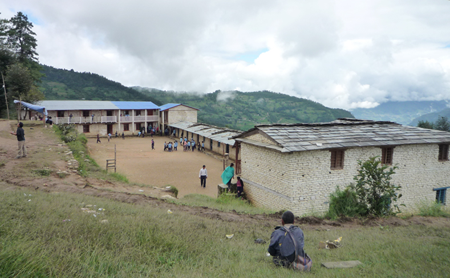
That night I had dinner together with Satomi, Chandra Sir, Jhaman Sir, Sunil Sir, Chris. We enjoyed some hours after dinner chatting and singing songs.
Day 4: Monday September 6, 2010
The next morning, I was taken to a nearby “Nangi Community Forest Nursery” (about 10 minutes walking from the school) by Nursery Baa. On the way to nursery, he showed me museum hall and solar water home. His actual name is Moti Bahadur Purja, 73, a retired British army who fought for Britain in World War II along with Ram Bahadur Limbu (a Nepali recipient of Victoria Cross). As he has been working in this nursery for more than 15 years, the villagers gave him a nickname: Nursery Baa (meaning nursery father). He told me his biography. I could also get a small biography of Mahabir Sir. It will require 4/5 more pages if I write the biography of Mahabir Sir here. He explained me the name and uses of different plants available in the nursery. He told me that the villagers can get a plant paying Re 1. Besides working as a paid-staff in this nursery, he is also a farmer. He is also involved in fish and rabbit farming.
I enquired about the population, occupation, religion, geography and other information of Nangi. As per him, the population is approx. 700 in which population of female is more than male by nearly 75. The main occupations of the villagers are agriculture and farming. The major crops grown in the village are maize, mustard, buckwheat, barley, wheat, etc.; vegetables such as potatoes, cauliflowers, cabbages, beans etc.; fruits such as apples, grapes, apricots, pears, plum, etc.; farming such as buffaloes, cows, goats, chickens, rabbits fishes etc. The main religion is Hindu and major festivals are: Dashain, Tihar, Janai Purnima and Maghe Sankranti. Nangi is situated in Ramche VDC. Ramche VDC consists of nine wards: Ward No. 1 and 2 (Nangi), Ward No. 3 and 4 (Ramche) and Ward No. 5 to 9 (Kafal Danda). There are some community groups including one mothers’ committee, one cultural committee, one community forest committee, one school management committee, and one village development committee.
He is very happy with Mahabir Sir’s initiative which he believed to help transform the village. The literacy rate is now improved. Even the adults can communicate in English. The adults also got the opportunity to learn computer, internet and email. The village in which at least one family member is working abroad (mostly in armed force either in Indian/British/Singapore Army or in gulf countries), the wireless technology has tremendously helped in facilitating communication. The equipment such as webcam helps to see one other while communicating. The clinic at Nangi with telemedicine facility is helping curing the normal diseases. In some critical cases, the health workers get proper consultancy as well.
We can see the mountains such as Dhaulagiri, Annapurna I, Machhapuchhre, Putali and Annapurna II from Nangi. These have attracted many tourists. The real station which is situated at six hours further climbing from Nangi is other attraction for the tourists. The one who wants to check the email or chat online should come to the school to enjoy the IT facility. There are two temples situated in a forest: Siddha Baba and Barahi Devi in nearly 20 minutes walking from the school. There is a belief that anyone comes with any wish and prays there, his/her wish be fulfilled. These temples are full with a large number of devotees in Janai Purnima. Life has become far better with the implementation of wireless technology in Nangi. The motorable linking road was developed with the effort of the principal Raman Sir last year. Though there is a road, it is not possible to take vehicle in rainy season. The linking road has facilitated in transporting their products down to Beni for marketing.
I had a query in my mind and asked, “I have heard most of the retired British armies are now in UK and many of them have got the British citizenship. Didn’t you get the opportunity to go in Britain?” He smiled and replied, “I got an opportunity to take my whole family in UK but I live in Nepal and live for Nepal.” He has a great pride being a Nepali. He said, “I am getting a good amount of pension and it is a mean for the country to earn some foreign exchange” and also added “Whatever I can do, I will do for my country till the end of my life.” I was touched and became speechless.
After about one and half hour conversation, he wished to take me to Siddha Baba and Barahi Devi temples. It is in ten minutes of walking from the nursery. I didn’t want to miss the chance and went with him. I paid homage to both Siddha Baba and Barahi Devi. As mentioned earlier, it is believed that anyone comes with any wish and prays there, his/her wish be fulfilled afterwards. That’s why, a large number of devotees come to pay homage to Siddha Baba and Barahi Devi every year especially in Janai Purnima, a religious festival of Hindu. I whole-heartedly thanked him and promised to be back to meet him in the next visit.
After spending memorable time with Nursery Baa, I returned back to school. It was already 12.15pm and everyone was in class and other activities, I prepared Chow Mein for lunch. Since I need to conduct a mini focus group discussion (FGD) aimed at developing idea for my research in the afternoon, I was mainly focusing on finalizing the questionnaires to be raised.
At 3.30, we started the mini FGD. There were only five villagers for this: Amar Bahadur Pun (Male, 63), Dil Bahadur Tilija (Male, 51), Suku Maya Pun (Female, 39), Gam Maya Pun (Female, 37) and Nama Maya Kharuja (Female, 31). I facilitated the discussion whereas Satomi remained as spectator as the discussion was in Nepali language. The FGD was conducted to observe their attitude and responds towards the affects brought by the wireless technology in Nangi. My main motive is to get answers on the following:
a) How technology is supporting people?
b) Are villagers able to access computer and internet equally?
c) How far the people who are residing far from the school or telemedicine center able to use the computer?
d) Are the villagers benefiting from the technology?
e) How technology changing the life of the people?
f) How effectively they are using technology?
g) Are they happy with this technology?
I could extract the following information after the mini FGD:
a. The technology is supporting villagers in communication, education, information, health and to some extent in trade. Each participant has at least one family member working abroad. So, they are able to communicate through internet (especially yahoo messenger). They could see the face of each other while chatting via webcam. They could also exchange the photos through emails. In the absence of the wireless technology, the communication would be very poor. They should depend on the general post office service which would require more than a month in receiving a letter. Even there is no assurance whether the letter is delivered to proper person or not. Similarly, the technology is also contributing in education. The level of knowledge of their children has increased and they have become wiser with the introduction of internet. Because of the technology, many volunteers have been visiting the village and offering their voluntary service. This has opened door for the students to learn relevant knowledge and skills from the volunteers around the world. This village has been getting good exposure in the international arena. The villagers are getting world wide information in a click.
The technology has aided in running telemedicine centre in Nangi. This has helped cure many normal diseases. The health-worker of Nangi clinic can consult with the senior doctors of Kathmandu Model Hospital and accordingly treatment has been done. If there is any serious case, the doctors refer them to go in nearby hospital where the treatment is possible. Hence, the technology is supporting in improving health status of the villagers.
To some extent, they get information about the price of the food grains and crops which are being traded in the nearby market. The FGD members have not participated but have heard about the trades being done through “Hatbazaar” (e-marketing). Mainly, the product such as buffaloes, goats, cows, honey, chicken, teas and jams are being marketed via e-marketing. But the e-marketing has not been that effective in the village.
b. Yes, villagers are able to access computer and internet but required to come to the school. Few villagers do have a computer in their home. The school has conducted few computer trainings including internet and email for villagers. Some motivated villagers go to school and learn. Even some villagers learn computer from their children. But for internet, the villagers should come to school. The internet is not available to any villagers at their home. The school provides villagers access to internet at the computer laboratory. There are nearly 20 computers in the computer laboratory.
c. The people who are far from the school and telemedicine centre are also able to use computer but they need to come to the school. The school does not discriminate for using computer. They are open but the network should be available. But the FGD members were unknown whether the people who are far from school have computer in their home. Similarly, the people who are far can also get the telemedicine service in Nangi.
d. The villagers are benefiting from wireless technology to a large extent. As mentioned earlier, the communication, education and health are the main sectors in which villagers are benefiting. Besides, they are also marketing some of their products through e-marketing. Utilising the wireless technology, the villagers are planning to open a cooperative. This move will not only encourage saving but also help villagers in getting loans in a relatively cheaper interest rate. More importantly, it will help in getting the remitted fund from their family members working abroad directly in the village. For this, the cooperative will get agency of some remittance companies. This move will certainly save the time, cost and effort going down to nearby towns to get the money.
Similarly, many international volunteers are visiting the village every year to volunteer in the wireless project. Apparently, the village is getting good exposure in international front.
e. The points mentioned above clearly indicate that the wireless technology is slowly and steadily changing the villagers’ life.
f. The villagers have not been able to reap the benefit to the optimum level yet. The teachers, students and villagers need to effectively utilize the technology. The teachers besides for communication purpose should extract resources which are useful to the students. The teachers should also learn the techniques to teach student more effectively. The students should also enhance the knowledge and level of wisdom utilizing internet. There are so many important sites which can help uplift their knowledge and wisdom level. I found that the villagers are not able to utilize the concept of e-marketing properly. There should be a good and effective mechanism from which the marketing of their products is eased. As far as possible, the technology should be made available in the home of villagers. Then, it will generate more fruitful results for the villagers.
g. Undoubtedly, the villagers are really very happy with this technology. The villagers from bottom of their heart thanked Mahabir Sir for his hard work in bringing this technology to this village. They pride to be in Nangi and whole heartedly appreciate Mahabir Sir for introducing this remote mountain village to rest of the world. The life has become very comfortable with this technology. They don’t want to imagine how life would have been in the absence of this technology.
I and Satomi thanked all five participants for their valuable time and wished for their good health, happiness, peace, progress and prosperity. They also reciprocated peace, progress and prosperity of Satomi and me. They hoped to see us again the next time.
In the evening, Chandra Sir, Jhaman Sir, Sunil Sir, Satomi, Chris and I gathered in the round house. That night, Sunil Sir and Satomi prepared the dinner and Chandra Sir and I washed the dishes. We conversed a lot that night. We sang songs and enjoyed a lot.
Day 5 and Day 6: Tuesday and Wednesday September 7 and 8, 2010
The next morning, Satomi left for Tikot at 7.30am. I went to Nangi clinic to see the functioning of telemedicine. How unlucky I was; even that day I could not have live experience due to the network problem. I had few minutes’ conversation with the health worker Madam Leela Pun. Besides, I inspected some hostels of the students. I could also visit the community library.
It was raining from early morning. I had no choice than to leave on the same day as I had to visit Kavreplanchok on September 9. I did not change my mindset and prepared to leave. I thanked Chandra Sir, Sunil Sir, Jhaman Sir, Krishna Sir and all other teachers for their sincere support and help. They were telling me to stay one more day to avoid the rain but I had no other alternative. In spite of heavy rains, I began my journey promising to be back in the village in the near future. They wished a safe and pleasant journey back to Kathmandu. In spite of heavy rains, I began my journey. I was bit emotional while leaving them. Following the same route, I descended. Though I was alone, it took five and half hours to get down to Beni. It was far easier than climbing up. Right after reaching Beni, I could see the bus ready to head for Kathmandu. Though I had a plan to stay one night in Beni, I got into the bus and left for Kathmandu at 4.00pm. It took nearly 18 hours to reach my home in Kathmandu as the continuous rains brought landslides in several parts which blocked the roads inviting huge traffic jams. It was the hardest ever bus travel I have experienced throughout my life. The journey ended after reaching home at 10.00am.
I would like to sincerely thank Mahabir Sir for his advice and encouragement. It would not be possible without his encouragement and guidance. Besides, I heartily thank Chandra Sir, Satomi and everyone who directly and indirectly helped me to complete this mission.
Nangi, “a heaven on earth”, I will come back soon!

